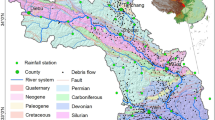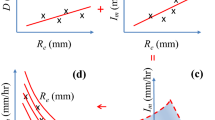Abstract
This study derives an empirical equation to determine the rainfall threshold that triggers landslides and subsequent debris flows. In this research, the contribution of different factors, especially various sediment layer thicknesses, was assessed on the landslide leading to debris flows. Bed slope, sediment thickness, sediment mean diameter, sediment layer length, rainfall intensity, and time of landslide occurrence were selected as the effective factors. Rainfall simulator device was used to create rainfall on the sediment sample. The effect of these factors on the landslide which leads to debris flow occurrence was investigated using dimensional analysis of experimental data. Then, linear and power regression models were tested by 30% of the total experimental data to estimate the rainfall-induced landslide. Determination coefficient (R2), mean absolute relative error (MARE), and Akaike information criterion (AIC) were applied to determine the best equation. Results revealed that landslide often occurs at a rapid rate in the thicker deposits than the thinner one. The evaluation of linear and power equations demonstrated that two-variable power model was the best empirical equation for estimation of rainfall threshold in initiation of landslide and debris flows. The evaluation criteria including MARE, R2, and AIC were estimated 0.044, 0.984, and − 25.93, respectively. In this equation, bed slope and the ratio of the time of landslide occurrence to the sediment layer length were used as the effective factors. This study can be used for assessment of the threshold of rainfall-induced landslide which finally leads to debris flow hazard.







Similar content being viewed by others
References
Aginam C, Chidozie N, Nwajuaku A (2015) Engineering properties of lateritic soils from Anambra Central Zone, Nigeria. Int J Soft Comput Eng 4:2231–2307
Ahmadi-adli M, Huvaj N, Toker NK (2017) Rainfall-triggered landslides in an unsaturated soil: a laboratory flume study. Environ Earth Sci 76:735
Banihabib ME (2002) Mud flow and debris. Proceeding of conference of Prevent and reduce of flood risks, Gorgan, Iran, pp 1-8
Banihabib ME, Forghani A (2017) An assessment framework for the mitigation effects of check dams on debris flow. Catena 152:277–284
Banihabib ME, Masumi A (2008) Effect of high-concentrated sediment transport on inundation of rivers: case study masuleh flood. Iranian Hydraulic Conference, pp 166-173
Chen X-Q, Cui P, Feng Z-L, Chen J, Li Y (2006) Artificial rainfall experimental study on landslide translation to debris flow. Yanshilixue Yu Gongcheng Xuebao/Chin J Rock Mech Eng 25:106–116
Chen Y, Irfan M, Uchimura T, Cheng G, Nie W (2018) Elastic wave velocity monitoring as an emerging technique for rainfall-induced landslide prediction. Landslides 15:1155–1172
Cogan J, Gratchev I (2019) A study on the effect of rainfall and slope characteristics on landslide initiation by means of flume tests. Landslides 16:2369–2379
Cui P, Guo X, Zhuang J (2014) Determination of the runoff threshold for triggering debris flows in the area affected by the Wenchuan earthquake. Nat Hazards Earth Syst Sci Discuss 2:4659–4684
Dahal RK, Hasegawa S (2008) Representative rainfall thresholds for landslides in the Nepal Himalaya. Geomorphology, 100(3-4):429–443.
Fuchu D, Lee C, Sijing W (1999) Analysis of rainstorm-induced slide-debris flows on natural terrain of Lantau Island, Hong Kong. Eng Geol 51:279–290
Gabet EJ, Mudd SM (2006) The mobilization of debris flows from shallow landslides. Geomorphology 74:207–218
Giannecchini R, Naldini D, Avanzi GDA, Puccinelli A (2007) Modelling of the initiation of rainfall-induced debris flows in the Cardoso Basin (Apuan Alps, Italy). Quat Int 171:108–117
Gregoretti C (2000a) Experimental evidence from the triggering of debris flow along a granular slope. Phys Chem Earth B Hydrol Oceans Atmos 25:387–390
Gregoretti C (2000b) The initiation of debris flow at high slopes: experimental results. J Hydraul Res 38:83–88
Guo X, Cui P, Li Y, Ma L, Ge Y, Mahoney WB (2016) Intensity–duration threshold of rainfall-triggered debris flows in the Wenchuan earthquake affected area, China. Geomorphology 253:208–216
Hassan-Esfahani L, Banihabib ME (2016) The impact of slit and detention dams on debris flow control using gstars 3.0. Environ Earth Sci 75:328
Hirano M (1997) Prediction of debris flow for warning and evacuation. Recent developments on debris flows. Springer, pp 7–26
Hu M, Zhang P, Wang R (2001) Study on inspiring effect of landslide experiment on condition of rainfall: example of slope piled by old landslide in jiangjiagou valley. J Water Soil Conserv 15:116–119
Hu W, Xu Q, van Asch T, Zhu X, Xu Q (2014) Flume tests to study the initiation of huge debris flows after the Wenchuan earthquake in SW China. Eng Geol 182:121–129
Huang C-C, Yuin S-C (2010) Experimental investigation of rainfall criteria for shallow slope failures. Geomorphology 120:326–338
Iverson RM (2015) Scaling and design of landslide and debris-flow experiments. Geomorphology 244:9–20
Kharismalatri HS, Ishikawa Y, Gomi T, Shiraki K, Wakahara T (2017) Small flume experiment on the influence of inflow angle and stream gradient on landslide-triggered debris flow sediment movement. Workshop on World Landslide Forum. Springer, pp 517–523
Kim MS, Onda Y, Uchida T, Kim JK, Song YS (2018) Effect of seepage on shallow landslides in consideration of changes in topography: case study including an experimental sandy slope with artificial rainfall. Catena 161:50–62
Klubertanz G, Laloui L, Vulliet L (2009) Identification of mechanisms for landslide type initiation of debris flows. Eng Geol 109:114–123
Larsen, MC Simon, A (1993) A rainfall intensity-duration threshold for landslides in a humid-tropical environment, Puerto Rico. Geografiska Annaler: Series A, Physical Geography, 75(1-2):13–23.
Liang W-J, Zhuang D-F, Jiang D, Pan J-J, Ren H-Y (2012) Assessment of debris flow hazards using a bayesian network. Geomorphology 171:94–100
Lora M, Camporese M, Salandin P (2016) Design and performance of a nozzle-type rainfall simulator for landslide triggering experiments. Catena 140:77–89
Lourenço SD, Sassa K, Fukuoka H (2006) Failure process and hydrologic response of a two layer physical model: Implications for rainfall-induced landslides. Geomorphology 73:115–130
Maore JM, Mihara M (2017) Development of portable artificial rainfall simulator for evaluating sustainable farming in Kenya. Int J Environ Rural Dev 8:27–32
Milne F, Brown M, Knappett J, Davies M (2012) Centrifuge modelling of hillslope debris flow initiation. Catena 92:162–171
Moriwaki H, Inokuchi T, Hattanji T, Sassa K, Ochiai H, Wang G (2004) Failure processes in a full-scale landslide experiment using a rainfall simulator. Landslides 1:277–288
Ni H-Y (2015) Experimental study on initiation of gully-type debris flow based on artificial rainfall and channel runoff. Environ Earth Sci 73:6213–6227
Papa M, Egashira S, Itoh T (2004) Critical conditions of bed sediment entrainment due to debris flow. Nat Hazards Earth Syst Sci 4:469–474
Qi X, Yu B, Ren J (2016) Experimental study on the formation of debris flow from landslide clastic deposition. International Journal of Georesources and Environment-IJGE (formerly Int’l J of Geohazards and Environment) 2:214-226
Schnellmann R, Busslinger M, Schneider HR, Rahardjo H (2010) Effect of rising water table in an unsaturated slope. Eng Geol 114:71–83
Senthil Kumar A, Sudheer K, Jain S, Agarwal P (2005) Rainfall-runoff modelling using artificial neural networks: comparison of network types. Hydrol Process 19:1277–1291
Shu AP, Wang L, Zhang X, Ou GQ, Wang S (2017) Study on the formation and initial transport for non-homogeneous debris flow. Water 9:253
Suradi M, Fourie A, Saynor M (2016) An experimental and numerical study of a landslide triggered by an extreme rainfall event in Northern Australia. Landslides 13:1125–1138
Takahashi T, Das DK (2014) Debris flow: Mechanics, prediction and countermeasures. CRC press
Tang C, Zhang S (2008) Study progress and expectation for initiation mechanism and prediction of hydraulic-driven debris flows. Adv Earth Science 8:000
Tanhapour M, Banihabib ME, Rouzbahani A (2018) Bayesian network model for the assessment of the effect of antecedent rainfall on debris flow forecasting in Alborz zone of Iran. Iran Water Resour Res 13:118–131
Tiwari B, Lewis A (2012) Experimental modeling of rainfall and seismic activities as landslide triggers. Geocongress 2012: State of the art and practice in geotechnical engineering, pp 471-478
Wang Y, Zhou R, Li C (1999) Research on the relationship between the erosion of debris flow and triggering rainfall. J Soil Water Conserv 5:34–38
Wu L, Zhou Y, Sun P, Shi J, Liu G, Bai L (2017) Laboratory characterization of rainfall-induced loess slope failure. Catena 150:1–8
Wu M-H, Wang JP, Chen I-C (2019) Optimization approach for determining rainfall duration-intensity thresholds for debris flow forecasting. Bull Eng Geol Environ 78:2495–2501
Yuan D, Liu J, You Y, Zhang G, Wang D, Lin Z (2019) Experimental study on the performance characteristics of viscous debris flows with a grid-type dam for debris flow hazards mitigation. Bull Eng Geol Environ 78:5763–5774
Zhou W, Tang C (2014) Rainfall thresholds for debris flow initiation in the Wenchuan earthquake-stricken area, southwestern China. Landslides, 11(5):.877–887.
Zhou SY, Gao L, Zhang LM (2019) Predicting debris-flow clusters under extreme rainstorms: a case study on Hong Kong Island. Bull Eng Geol Environ 78:5775–5794. https://doi.org/10.1007/s10064-019-01504-3
Zhuang J-Q, Cui P, Peng J-B, Hu K-H, Iqbal J (2013) Initiation process of debris flows on different slopes due to surface flow and trigger-specific strategies for mitigating post-earthquake in old Beichuan County, China. Environ Earth Sci 68:1391–1403
Zhuang J, Cui P, Wang G, Chen X, Iqbal J, Guo X (2015) Rainfall thresholds for the occurrence of debris flows in the Jiangjia Gully, Yunnan Province, China. Eng Geol 195:335–346
Acknowledgments
The authors express their thanks to the watershed and soil conservation institution authorities due to providing the rainfall simulator device for the experiments.
Author information
Authors and Affiliations
Corresponding author
Rights and permissions
About this article
Cite this article
Banihabib, M.E., Tanhapour, M. An empirical equation to determine the threshold for rainfall-induced landslides developing to debris flows. Landslides 17, 2055–2065 (2020). https://doi.org/10.1007/s10346-020-01430-6
Received:
Accepted:
Published:
Issue Date:
DOI: https://doi.org/10.1007/s10346-020-01430-6




